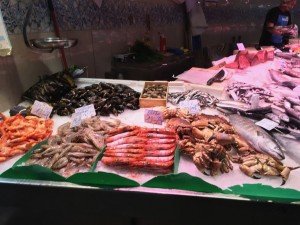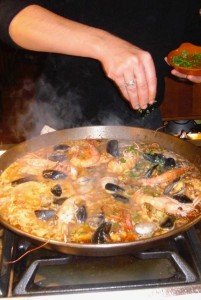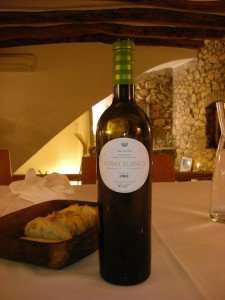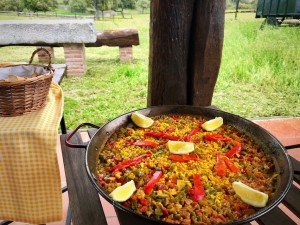Costa Rica's Favorite Meal: The Casado
February 7, 2025
Costa Rica is a fabulous destination for luxury travelers, as well as seniors, couples, and families, not least because of its many excellent dining options.…
Read This Post The Italians have risotto. But in Spain, it’s all about paella. The dish originated in the region of Valencia, where it was once the purview of farmers who made it as a one-pot meal over a fire for lunch; it was essentially made with rice and whatever other ingredients the farmers had on hand. Today, however, you will find it throughout Spain, where it has become a sort of national dish. Jump down to see a paella recipe.
The Italians have risotto. But in Spain, it’s all about paella. The dish originated in the region of Valencia, where it was once the purview of farmers who made it as a one-pot meal over a fire for lunch; it was essentially made with rice and whatever other ingredients the farmers had on hand. Today, however, you will find it throughout Spain, where it has become a sort of national dish. Jump down to see a paella recipe.  When deciding on a paella wine pairing, you should keep in mind that there are different kinds of paella, and they may require different wine pairings. Paella Valenciana is traditionally is made with rice, beans, green vegetables, meat, land snails, and seasoning. Seafood paella (or paella de marisco) is also popular, as is a mixed paella – or paella mixta – which combines seafood and meat with vegetables, and of course, rice. Less common but still delicious are vegetarian paella (paella vegetariana), as well as paella negra, which is made with seafood and squid ink, which turns the rice black. Get five tips on how to make paella, from our Cooking Andalusian Olive Country cooking vacation.
When deciding on a paella wine pairing, you should keep in mind that there are different kinds of paella, and they may require different wine pairings. Paella Valenciana is traditionally is made with rice, beans, green vegetables, meat, land snails, and seasoning. Seafood paella (or paella de marisco) is also popular, as is a mixed paella – or paella mixta – which combines seafood and meat with vegetables, and of course, rice. Less common but still delicious are vegetarian paella (paella vegetariana), as well as paella negra, which is made with seafood and squid ink, which turns the rice black. Get five tips on how to make paella, from our Cooking Andalusian Olive Country cooking vacation.  Even with the wide range of flavors and ingredients in paella, it’s quite easy to pair paella with wine. One great general rule of thumb is this: what grows together, goes together. In other words, Spanish wines usually go well with traditional Spanish paella. Learn about pairing wine with fish and seafood. Want more guidance? Some would say that wines from the region of Rioja, in general, make the best wine with paella. These food-friendly wines – which include rosés, reds, and whites – work so well because most go with everything from meats to vegetables, making them a perfect wine for paella. For example, rioja reds, many made with Tempranillo grapes, pair well with seafood paellas, as do many white wines. Valencia or mixed paellas, on the other hand, work particularly well with dry rosés and red Grenaches. As long as the wine isn’t too fruity or contains a lot of tannins, chances are it’ll work well in your paella dish. Taste Rioja wines and cook in Spain’s Basque Country. Of course, you can venture outside of Spanish wines, and if you do, stick to rosés and lighter reds, such as those from France’s Languedoc region.
Even with the wide range of flavors and ingredients in paella, it’s quite easy to pair paella with wine. One great general rule of thumb is this: what grows together, goes together. In other words, Spanish wines usually go well with traditional Spanish paella. Learn about pairing wine with fish and seafood. Want more guidance? Some would say that wines from the region of Rioja, in general, make the best wine with paella. These food-friendly wines – which include rosés, reds, and whites – work so well because most go with everything from meats to vegetables, making them a perfect wine for paella. For example, rioja reds, many made with Tempranillo grapes, pair well with seafood paellas, as do many white wines. Valencia or mixed paellas, on the other hand, work particularly well with dry rosés and red Grenaches. As long as the wine isn’t too fruity or contains a lot of tannins, chances are it’ll work well in your paella dish. Taste Rioja wines and cook in Spain’s Basque Country. Of course, you can venture outside of Spanish wines, and if you do, stick to rosés and lighter reds, such as those from France’s Languedoc region.
 What Wine to Drink with Paella
What Wine to Drink with PaellaSo, what is the perfect wine for paella? The good news is you do have many choices!
The best wine for paella Valenciana, as mentioned above, might be a dry rosé or a medium-bodied red. Try a rosé from Navarra, a Granache, or a red from Valencia’s Terres dels Alforins wine-producing area. But if you want a white, try a robust white wine from the Priorat.
For a paella mixta, you might try a white Merseguera, produced in the high Alto Turia area. Its acidity will work well with the combination of ingredients. Or, a Tempranillo/Grenache blend from Rioja is also a great wine with paella mixta.
When thinking about paella and wine, remember to keep in mind the base ingredients. For seafood paellas, although you don’t have to stick with white wine, it’s still always a good bet. So try a good Sauvignon Blanc or a Cava – Spain’s famed sparkling wine that pairs well with everything!
Serves: 8 Prep time: 20 minutes Cook time 25 minutes Cook method: Pan fry, Simmer

1. Place the paella pan (or frying pan) on mid-heat, and cover the base in olive oil. When hot, slowly add the diced meat into the pan. Lightly fry the meat until it’s slightly golden on all sides, then add all the chopped vegetables and squid (sliced into rings) into the pan. 2. Keep the pan on high heat stirring occasionally while it simmers for 5-7 minutes. 3. While stirring the mixture with a wooden spoon, pour the rice into the mix. The rice will start to absorb the juices and flavors of the other ingredients. 4. When the rice starts to turn from white to an opaque transparent color, add the white wine and stir for 1 minute until the alcohol evaporates. 5. Now add the fish stock uniformly in the pan but leave some in the jug, in case you need it later in the preparation. 6. Turn the heat to low, and add the mix of saffron, turmeric, and garlic. 7. When the stock starts to boil add the mussels, clams, and prawns in a symmetrical circular fashion. From this moment on, you must move the pan every 1 or 2 minutes in a circular motion using the two handles, so you don’t disturb the seafood ingredients and so the rice doesn’t stick to the base of the pan.  8. Every so often try a piece of rice until the center of the grain ceases to have a chalky taste. When the rice reaches this point, turn off the heat and cover the pan with a cloth. Leave it like this for 5 minutes before serving. Try Chef Clive’s delicious Salmorejo soup. Want to learn more about paella and other traditional dishes of Spain? Take a cooking vacation to this sun-drenched, beautiful country. By Peg Kern Find more photos, food facts, and travel stories from The International Kitchen on Facebook, Instagram, Pinterest, YouTube and Twitter.
8. Every so often try a piece of rice until the center of the grain ceases to have a chalky taste. When the rice reaches this point, turn off the heat and cover the pan with a cloth. Leave it like this for 5 minutes before serving. Try Chef Clive’s delicious Salmorejo soup. Want to learn more about paella and other traditional dishes of Spain? Take a cooking vacation to this sun-drenched, beautiful country. By Peg Kern Find more photos, food facts, and travel stories from The International Kitchen on Facebook, Instagram, Pinterest, YouTube and Twitter.